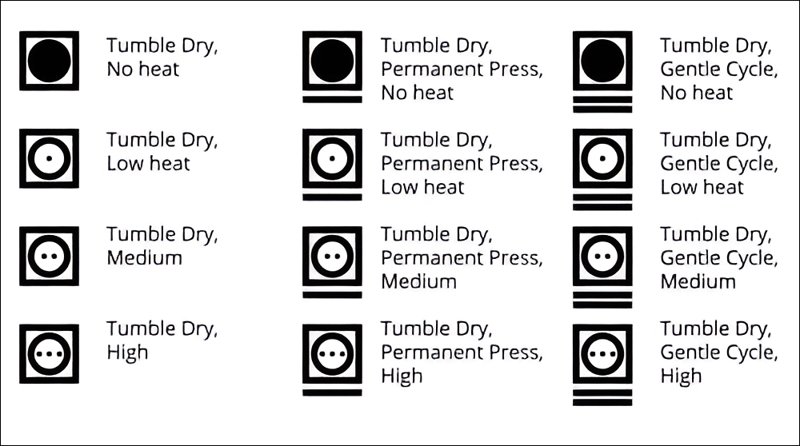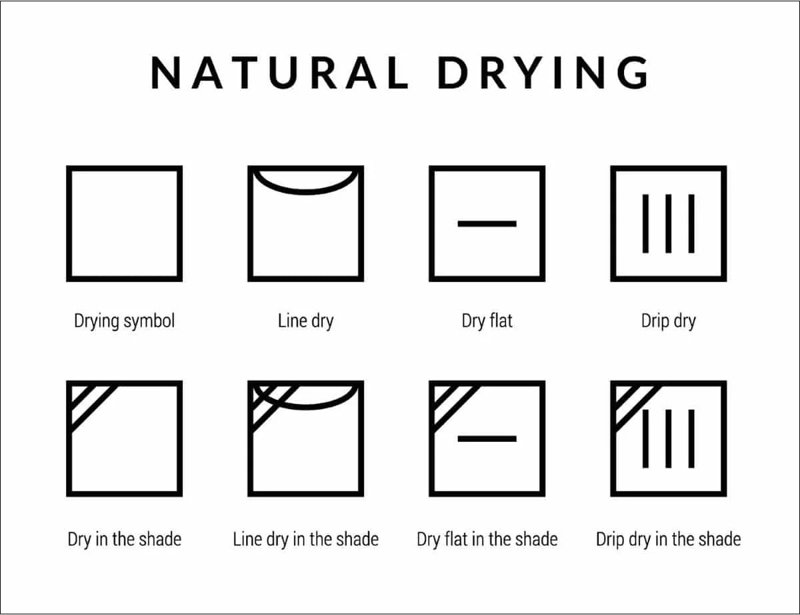Drying Instructions: Decode Labels, Save Your Clothes
Ever pulled a beloved piece of clothing from the laundry, only to find it mysteriously shrunk or looking worn out far too soon? That small tag inside your garment, the care label, holds the key to avoiding these laundry mishaps, particularly when deciphering how to dry items correctly. Drying instructions are a crucial part of the garment care label (the tag detailing washing and care recommendations).
These specific guidelines, often shown as symbols or text, are fundamental to proper fabric care, helping to maintain the garment’s original size, shape, texture, and color.. Following these laundry instructions is fundamental to proper fabric care, helping to maintain the garment’s original size, shape, texture, and color. This guide serves as a comprehensive resource for understanding drying instructions.
1. The Real Cost of Ignoring Drying Instructions
1.1 Shrinkage & Stretching
Disregarding care labels often leads to noticeable garment damage, primarily through changes in size. The combination of moisture and heat affects various clothing materials differently. Natural fibers like wool and cotton are particularly susceptible; their complex structures absorb water, and excessive heat during drying causes these fibers to contract rapidly and unevenly, resulting in shrinkage.
Conversely, some materials, especially loosely knit garments or certain synthetics, can stretch out of shape if tumbled aggressively or hung incorrectly while heavy with water. This dimensional instability fundamentally alters the garment’s fit.
1.2 Irreversible Fabric Damage
Beyond simple size changes, improper drying inflicts lasting harm on the fabric itself. High heat can cause pilling (small balls of fuzz) on knitted items, making them look old and worn. Synthetics like polyester or nylon are vulnerable to melting or developing a permanent shiny appearance if the temperature is too high.
Even seemingly robust fabrics suffer from fiber damage at a microscopic level when subjected to harsh drying conditions repeatedly; the fibers weaken, become brittle, and are more prone to snagging and tearing over time.
1.3 Color Fading & Bleeding
The vibrancy of your clothes is also at risk. High temperature settings in a dryer can accelerate the breakdown of dyes within the fabric, leading to gradual color fading. For certain dyes, particularly in newer or brightly colored garments, the heat can also cause color bleeding, where dye transfers onto other items in the load.
Air drying isn’t immune to color issues either; drying colored garments in direct sunlight can have a bleaching effect, causing uneven fading and reducing the intensity of the hues over time, hence the “Dry in Shade” instruction for susceptible items.
1.4 Financial & Reputational Impact
For consumers, the consequence of ignoring drying instructions is primarily financial – ruined clothes need replacing, wasting money. For small businesses operating in the apparel industry, the impact extends further.
Providing incorrect or unclear care labels can lead to increased returns and customer complaints when garments are damaged through no fault of the buyer. This not only incurs direct costs but also damages brand trustworthiness and negatively impacts overall customer satisfaction, potentially harming the business’s reputation in the long run.
2. Your Visual Guide to Drying Instructions
2.1 The Foundation

Understanding drying instructions starts with recognizing the basic symbol used internationally: a plain square. This square signifies the drying process in general, forming the foundation upon which all specific drying instructions are built.
2.2 Tumble Drying

Basic Tumble Dry Symbol
A square containing a plain circle indicates that the garment is suitable for Tumble Dry or Machine Drying using a standard household dryer. This is the most general allowance for machine drying.
Understanding Heat Levels (Dots)
The heat intensity for machine drying is specified by dots inside the circle, crucial for Temperature Control:
- One Dot: Symbolizes Low Heat. Use this setting for delicate fabrics, synthetics that could melt or warp, or items prone to shrinking.
- Two Dots: Represents Medium Heat. Suitable for permanent press items and some synthetics that can tolerate moderate temperatures.
- Three Dots: Indicates High Heat. Generally reserved for sturdy items like cotton towels, bedding, and jeans that can withstand higher temperatures without damage.
- Filled Circle: Means No Heat / Air Fluff. The dryer tumbles the clothes without adding heat, useful for fluffing items or refreshing them without washing.
Cycle Specifics
Lines underneath the main tumble dry symbol dictate the specific machine cycle recommended:
- Single Underline: Calls for the Permanent Press cycle. This cycle typically uses medium heat and includes a cool-down period to help reduce wrinkling.
- Double Underline: Specifies the Delicate Cycle or Gentle Cycle. This setting uses low heat (or sometimes no heat) and minimal tumbling action or slower spin speeds to protect fragile items.
The Prohibition
A square with a circle inside, overlaid with a large ‘X’, is an unambiguous instruction: Do Not Tumble Dry. Placing this garment in a machine dryer, regardless of heat setting or cycle, risks causing significant damage like shrinkage, melting, or distortion.
2.3 Air Drying (Natural Drying)

Line Dry Symbol
A square containing a curved line resembling a sagging clothesline means Line Dry. The garment should be hung damp on an indoor or outdoor clothesline, or placed on a hanger, to Air Dry.
Drip Dry Symbol
A square with three vertical lines inside indicates Drip Dry. This requires hanging the garment while still quite wet (without wringing or extensive spinning beforehand), allowing water to drip out as part of the Air Dry process. This is often recommended for items that wrinkle easily or could be damaged by spinning.
Dry Flat Symbol
A square with a single horizontal line in the center instructs to Dry Flat. After washing, gently squeeze out excess water, reshape the garment to its natural dimensions, and lay the article flat on a clean, dry surface, such as a towel laid over a drying rack. This method is essential for heavy knits and wool sweaters which can stretch out of shape if hung. This is a form of Air Dry.
Dry in Shade Symbol
Two diagonal lines in the top left corner of the drying square (often combined with another Air Dry symbol like Line Dry or Dry Flat) mean Dry in Shade. This instruction signifies the need to keep the garment away from direct Sunlight during drying to prevent color fading or potential fiber damage caused by UV rays.
2.4 Do Not Dry

A plain square overlaid with a large ‘X’ is the Do Not Dry symbol. This uncommon instruction usually indicates that the garment should not be dried using any conventional home methods (machine or air). Often, these items require specialized Professional Cleaning or have very specific manufacturer instructions detailed elsewhere on the label or packaging. Consulting the full label or seeking professional advice is necessary.
3. Selecting the Right Drying Method
3.1 Mastering Machine Drying
Matching Symbols to Dryer Settings
Translating the care label symbols to your clothes dryer controls is straightforward. The dots indicating temperature correspond directly to your machine’s heat settings: one dot means select “Low Heat” (often found on the Delicate Cycle setting), two dots point to “Medium Heat” (usually associated with Permanent Press cycles), and three dots mean “High Heat” (typically for cotton or heavy-duty cycles).
Similarly, the underline symbols guide your cycle selection: one underline matches the Permanent Press cycle designed to minimize wrinkles, while two underlines necessitate the Delicate Cycle or Gentle Cycle, which uses lower heat and reduced tumbling action. While specific names on dials or buttons may vary slightly between dryer models, the principles linked to the symbols remain consistent.
Fabric Suitability
While the care label is the ultimate authority, some general guidelines exist regarding fabric suitability for the dryer. Sturdy natural fabrics like cotton (e.g., towels, jeans) and linen, along with many robust synthetics (polyester, nylon blends), often tolerate machine drying well, provided the correct heat setting is used.
Conversely, delicate materials such as silk, wool, rayon, lace, and items with embellishments generally require air drying or very low heat settings to prevent damage. The specific weave and finish of a fabric type also play a role, reinforcing the rule: *always* prioritize the garment’s specific care label instructions over general assumptions.
Expert Tips for Dryer Use
- Avoid Overloading: Do not pack the dryer drum tightly. Clothes need space to tumble freely for efficient air circulation, which leads to faster, more even drying and helps reduce wrinkling.
- Clean the Lint Trap: Make cleaning the lint trap a habit *after every single load*. A clear trap improves drying efficiency by allowing proper airflow and significantly reduces the risk of fire hazards.
- Shake Before Drying: Briefly shake out clothes as you transfer them from the washer to the dryer. This helps separate items, reducing drying time and minimizing wrinkles set during the spin cycle.
3.2 Implementing Air Drying Methods
Implementing the Instructions
Executing air dry instructions involves simple setups:
- Line Dry: Hang garments on an outdoor clothesline, an indoor drying rack with bars, or sturdy hangers. Ensure items hang freely with space for air circulation.
- Drip Dry: Hang the very wet garment (without prior wringing or intensive spinning) on a waterproof hanger over a bathtub, shower basin, or a protected area where dripping water won’t cause damage.
- Dry Flat: Gently squeeze excess water from the garment (do not wring). Lay the article flat in its natural shape on a horizontal surface, such as a mesh drying rack or a clean, dry towel spread on a table or floor.
- Dry in Shade: For any air-drying method specified, choose a location away from direct sunlight, such as a shaded porch, an indoor room away from windows, or under an awning.
Best Practices for Air Drying
- Shape Garments: When using the Dry Flat method, especially for wool and heavy knits, carefully arrange the garment to its original shape and dimensions. Shaping garments properly while damp prevents stretching and distortion as they dry.
- Use Appropriate Hangers: For Line Dry items, particularly delicates or knits, consider using padded or broad, smooth hangers to avoid creating shoulder bumps or stretching the fabric.
- Ensure Airflow: Regardless of the method, ensure good air circulation around drying clothes. Avoid bunching items closely together. A fan (on a low setting, not pointed directly at delicate items) can speed up indoor drying.
- Manage Dripping: When using Drip Dry, place a towel or container beneath the garment to catch water, especially if drying indoors over surfaces not designed for water exposure.
3.3 Why Specific Methods Matter?
Understanding fabric properties clarifies why certain drying methods are essential. Wool and heavy knit clothing material fibers absorb significant water, making the garment heavy. Hanging these items (Line Dry) allows gravity to stretch the fibers, especially at the shoulders, permanently distorting the shape; hence, Dry Flat provides necessary support. Silk fibers are proteins sensitive to high heat, which can make them brittle, dull their luster, and weaken the fabric structure.
Many synthetics, like certain polyesters or acrylics, have lower melting points and can literally melt, glaze (develop shiny patches), or deform if subjected to excessive heat in a dryer. Following the label prevents these material-specific damages.
4. Avoiding Common Laundry Disasters
4.1 Ignoring the Care Label
The most frequent origin of laundry mishaps, particularly during drying, stems from simply neglecting to check or follow the garment’s care label. This small tag holds the manufacturer’s specific guidance, tailored to the fabric and construction of the item.

4.2 The Heat Trap
Using high heat settings on the dryer is tempting for faster drying times. However, this is a primary contributor to irreversible shrinkage and fiber damage, especially when dealing with garments whose fabric composition is uncertain. When in doubt about an item’s heat tolerance, the safest course of action is always to default to a lower heat setting or opt for air drying.
4.3 Forcing It
Items marked with the Do Not Tumble Dry symbol should never be placed in a machine dryer. Even using ‘low heat’ or ‘air fluff’ settings can cause damage. The physical tumbling action itself, regardless of temperature, can lead to stretching, snagging, or distortion for fabrics unsuitable for machine drying. Respecting this symbol is crucial to preserve the garment. Always avoid the urge to tumble dry these specific items.
4.4 Air Drying Errors
Even air drying can go wrong if done improperly. Common mistakes include hanging heavy knitwear or sweaters on hangers (line drying), which leads to shoulder bumps and irreversible stretching due to the weight of the wet fabric.
Another frequent error is drying brightly coloured or dark garments in direct sunlight, causing noticeable fading. The solutions lie in using the appropriate air-dry method indicated on the label (Dry Flat for heavy items, Line Dry for others) and always heeding the Dry in Shade instruction when present.
4.5 Overdrying Syndrome
Leaving clothes in the dryer long after they are dry contributes to overdrying. This practice not only wastes energy but also harms fabrics over time. Excessive heat exposure can make fibers brittle, increase static cling, and accelerate wear and tear, ultimately reducing the longevity of clothing. Utilizing a dryer’s moisture sensor, if available, helps prevent this. Alternatively, checking clothes periodically and removing them as soon as they feel dry is an effective manual approach.
5. Essential Guidance for Small Clothing Businesses
5.1 Why Accurate Care Labels Matter
For small businesses in the apparel industry, providing accurate care labels is not merely a suggestion; it’s a crucial business practice that underscores professionalism and reliability. In the United States, adherence to the FTC Care Labeling Rule (a federal regulation mandating that manufacturers and importers attach clear, uniform care instructions to garments) is a legal requirement. Beyond compliance, clear and correct labels are fundamental to building brand reputation and trust.
When customers can successfully care for their purchases, customer satisfaction increases significantly, fostering loyalty. Conversely, unclear or incorrect instructions often lead to damaged garments, resulting in costly returns, negative reviews, and erosion of brand credibility demonstrating this level of care and expertise directly contributes to how knowledgeable, authoritative, and trustworthy your brand is perceived, vital factors in today’s market.
5.2 Sourcing & Applying Correct Symbols
Ensuring the symbols used on care labels are correct and universally understood is paramount, especially if targeting international markets. Utilizing standardized symbols, such as those governed by GINETEX (the International Association for Textile Care Labelling) or outlined within ISO 3758 (an international standard for textile care codes), promotes clarity and avoids misinterpretation across different languages and regions.
Maintaining consistency in the symbols and terminology used across your entire product range also helps build brand recognition and simplifies the care process for repeat customers. Partnering with label suppliers who are knowledgeable about these standards and regional requirements can be invaluable in sourcing and applying the correct symbols accurately.
5.3 Customer Education
Supplementing the sewn-in care label with additional forms of customer education can significantly enhance the customer experience and further reduce care-related issues. Consider including a brief summary of essential washing instructions and drying instructions on hang tags.
On your e-commerce website, detailed care information within product descriptions provides value before purchase. Creating a dedicated “Garment Care Guide” section on your website serves as a helpful resource for customers and positions your brand as knowledgeable and supportive. Frame this information not just as instructions, but as helpful guidance to ensure customers enjoy their purchases for as long as possible.
5.4 Risk Mitigation
Providing comprehensive and accurate laundry instructions, with particular attention to drying methods, is a direct form of risk mitigation for apparel businesses. When consumers inadvertently cause garment damage due to ambiguous or faulty care guidance, the result is often dissatisfaction, complaints, and returns.
Each return represents not only a financial loss (cost of goods, shipping, processing) but also potential damage to the brand’s reputation. Clear, precise drying instructions empower customers to care for products correctly, drastically reducing the likelihood of such preventable issues and protecting your bottom line.
6. Related Questions
6.1 What’s the difference between “Tumble Dry Low” and “Delicate Cycle”?
While often used together, these terms refer to slightly different aspects of machine drying. “Tumble Dry Low” specifically dictates the temperature setting – it means using the lowest heat option available on your dryer. The “Delicate Cycle,” on the other hand, refers to the overall program which typically combines low heat (or sometimes no heat) with gentler tumbling action and often a slower spin speed. Therefore, a Delicate Cycle inherently uses low heat, but it also modifies the physical movement within the dryer to better protect fragile items. Always check if the label specifies one or both.
6.2 Can I dry different fabric types together if they all say “Tumble Dry”?
While technically possible if all items allow tumble drying, it’s generally best practice to sort laundry by fabric weight and recommended drying temperature before machine drying. Drying heavy cotton towels with lightweight synthetics, even if both labels permit tumble drying, can lead to uneven results; the lighter items may overdry and suffer damage while the heavier ones remain damp. If combining items, always default to the lowest temperature requirement among the load and be mindful that lint transfer can occur between different fabric types. Checking each item’s label remains the most reliable approach.
6.3 How can I speed up air drying time?
Several techniques can help accelerate the Air Dry process, especially indoors or in humid conditions. Maximizing airflow is key: ensure garments are well-spaced on the line or rack, and consider placing a fan nearby (set to low, not blowing directly on delicates) to circulate air.
For non-delicate items, gently rolling them in a clean, dry towel after washing can absorb significant excess moisture before hanging, reducing overall drying time. Ensure the drying location itself is well-ventilated.
6.4 Do drying instructions relate to using dryer sheets?
Core drying instructions (symbols indicating heat level, cycle type like Delicate Cycle, or method like Air Dry) do not directly dictate the use of dryer sheets. Dryer sheets are primarily fabric softeners and static reducers, added to the dryer drum to impart these qualities during the cycle.
While most items suitable for tumble drying can tolerate dryer sheets, some care labels for very delicate fabrics, performance wear, or children’s sleepwear might specifically advise against using them due to potential residue buildup affecting fabric properties (like moisture-wicking or flame resistance). The decision to use a dryer sheet is separate from adhering to the fundamental drying temperature and method instructions.
Read more:
Deciphering garment care labels, especially the often-confusing drying symbols, is no longer a mystery. Understanding tumble dry settings, delicate cycles, and air-drying methods like line or flat drying is crucial. Adhering to these guidelines, alongside proper washing and ironing instructions, prevents damage like shrinking or fading, significantly extending garment lifespan. For consumers, this protects their wardrobe; for businesses, it ensures customer satisfaction and reinforces brand quality. Always check and follow the care label – it’s the key to lasting apparel quality.

















